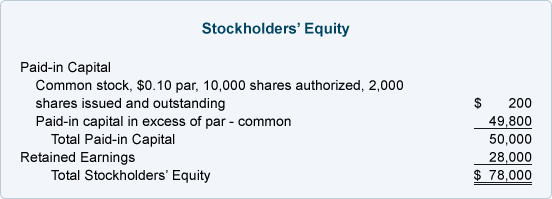How to calculate retained earnings formula + examples

On one hand, high retained earnings could indicate financial strength since it demonstrates a track record of profitability in previous years. On the other hand, it could be indicative of a company that should consider paying more dividends to its shareholders. This, of course, depends on whether the company has been pursuing profitable growth opportunities. On the other hand, though stock dividends do not lead to a cash outflow, the negative retained earnings stock payment transfers part of the retained earnings to common stock. For instance, if a company pays one share as a dividend for each share held by the investors, the price per share will reduce to half because the number of shares will essentially double. Because the company has not created any real value simply by announcing a stock dividend, the per-share market price is adjusted according to the proportion of the stock dividend.
- Now, you must remember that stock dividends do not result in the outflow of cash, in fact, what the company gives to its shareholders is an increased number of shares.
- On the other hand, it could be indicative of a company that should consider paying more dividends to its shareholders.
- A net profit would mean an increase in retained earnings, where a net loss would reduce the retained earnings.
- In some cases, a company's negative retained earnings may result from underlying problems with the business model or operations.
What is Negative Retained Earnings?
Your business’s balance sheet is filled with figures that spell out your business’s financial health. It may be tempting to keep things simple with a final profit or loss amount, but each line item helps you understand how and why your business is making or losing money. One of those figures is called retained earnings if in the black or negative retained earnings if in the red. Here, we’ll focus on what negative retained earnings mean and what they indicate for the success of your business.
- With careful planning and strategic decision-making, a company with negative retained earnings may be able to turn its financial situation around and build a stronger foundation for future growth.
- Retained earnings also provide your business with a cushion against any economic downturn and give you the requisite support required to sail through depression.
- Companies may pay out either cash or stock dividends, and in the case of cash dividends they result in an outflow of cash and are paid on a per-share basis.
- If the company has been operating for a handful of years, an accumulated deficit could signal a need for financial assistance.
- This money can partly be distributed as dividends to the stockholders, while also being reinvested for business growth.
How are retained earnings calculated?
The implications of such a downturn extend beyond mere numbers on a balance sheet; they touch upon a company’s future https://www.bookstime.com/articles/payroll-automation prospects, investor confidence, and overall market perception. To understand negative retained earnings, it’s important to define retained earnings. Once your business pays all its taxes, expenses, and other debts owed each period – including your shareholders’ dividends, if applicable -- the money left over is called retained earnings. Funds from retained earnings are often used to reinvest back in the company and fuel future growth, but it’s also important to keep a portion on hand to ensure your business’s long-term financial health. This is the amount of retained earnings to date, which is accumulated earnings of the company since its inception.

Causes of Negative Retained Earnings
This means each shareholder now holds an additional number of shares of the company. Dividends are paid out of retained earnings of the company, and using both cash and stock dividends can lead to a decrease in the retained earnings of the company. If a company has negative earnings, it means it reported a loss for the specified time period. This may mean that a company is either losing money and is experiencing some financial difficulty. In other cases, companies may post negative earnings (or losses) if they are spending more than they did in the past. This isn't necessarily a bad thing as it may indicate the company is investing more in its future.

Being better informed about the market and the company’s business, the management may have a high-growth project in view, https://x.com/BooksTimeInc which they may perceive as a candidate for generating substantial returns in the future. Retained earnings are also called earnings surplus and represent reserve money, which is available to company management for reinvesting back into the business. When expressed as a percentage of total earnings, it is also called the retention ratio and is equal to (1 - the dividend payout ratio). For this reason, retained earnings decrease when a company either loses money or pays dividends and increase when new profits are created. Although seeing the word “negative” in a business context may draw up feelings of unease, negative retained earnings are not always a bad sign. They are less troubling for young companies with an impressive growth trajectory, a phenomenon common among some of the largest internet and tech companies.
- We may earn a commission when you click on a link or make a purchase through the links on our site.
- It also helps investors get a quick view of how much profit the business is holding onto.
- It can go by other names, such as earned surplus, but whatever you call it, understanding retained earnings is crucial to running a successful business.
- Remember, one of the ways we can determine the quality of management and their views on shareholder value remains to decipher the retained earnings and what management does with them.
- This financial measure is a testament to the company’s ability to generate profits and retain them for future use, such as expansion or debt reduction.
Learn the art of investing in 30 minutes
Retained earnings appear on the liability side of your company’s balance sheet under shareholders’ equity and act as an important source of self-financing or internal financing. Negative retained earnings refer to the total amount of loss posted by a company when it exceeds any previously recorded profit. So if the company above posted a loss of $20,000 this year instead of a profit, it ends up with negative retained earnings of $10,000.

Create a Free Account and Ask Any Financial Question

A financial professional will offer guidance based on the information provided and offer a no-obligation call to better understand your situation. 11 Financial may only transact business in those states in which it is registered, or qualifies for an exemption or exclusion from registration requirements. 11 Financial’s website is limited to the dissemination of general information pertaining to its advisory services, together with access to additional investment-related information, publications, and links.

Therefore, a company with a large retained earnings balance may be well-positioned to purchase new assets in the future or offer increased dividend payments to its shareholders. It can be used to pay dividends, invest in business growth, or saved as a safety net for tough times. They are part of a bigger financial picture that gives insight into your company’s overall performance. Understanding how retained earnings fit with other financial metrics helps guide smarter business decisions for long-term success and sustainability. The companies sometimes prepare a separate report called the statement of retained earnings in addition to the usual balance sheet and income statement.
How to Start a Successful Bookkeeping Business: 15 Steps
If you’re reading this, it means you see the opportunity, and you’ve already asked yourself the important questions every entrepreneur needs to answer. You want to help businesses by starting your own bookkeeping business. And we want to help you figure out how to get out there and land your first client. Additionally, bookkeepers must follow document retention standards. An audit can happen to any client, so in order to help auditors and the IRS, well-kept records and records kept for the allotted time period are critical during an inspection.
Creating a Business Plan for Your Bookkeeping Business
When you start any new business, you can’t expect customers or clients to magically find you. Instead, you’ll have to invest some time (and perhaps, money) in marketing your business. https://beregovo.info/advert/?tag=%d0%b8%d0%bb%d0%be%d0%bd-%d0%bc%d0%b0%d1%81%d0%ba A business plan is a detailed overview of how you plan to launch and grow your business. There are several key elements that are typically included in a comprehensive business plan.
- It will likely be the first form of financing you’ll qualify for and can be a great financial tool to help you with cash flow or necessary expenses early on in your business.
- While individuals may have to take additional classes or bootcamp-style preparation courses, you can be well on your way to a career in the field in as soon as a few months.
- You’ll need bookkeeping insurance as you’re providing an essential service for businesses.
- According to a recent report, the industry’s revenue is expected to reach $3.9 billion by 2025 which represents a growth of 3.3% from 2020.
- Once you've identified a potential target market, take time to create client personas.
- The other part you need to have is a simple, repeatable sales process to land any new clients you’ve attracted.
Comprehensive Preparation and Market Analysis
From setting up your business structure to marketing your brand, you’re now on the path to a well-planned startup. A bookkeeping business specializes in recording and maintaining the financial https://www.megapolis.org/israel/ind536.html transactions of other businesses. Unlike comprehensive accounting services, bookkeeping focuses more on tracking daily financial activities, including purchases, receipts, sales, and payments.
Continuous Learning and Adaptation
Typically, these spaces include a mailing address, a local telephone number, a receptionist to answer calls, a physical office space, and access to a conference room that you can rent by the hour. To assist you with this decision, I recommend that you get an introduction to the four common business structures by reading our small business structure guide. The Zoho Books Consulting Partner program is free to join and gives you access to Zoho training resources and certifications. You’ll receive a dedicated account manager and free access to the Premium plan when you become a Zoho Advisor. However, there are a few questions that should be swirling around your head.
How much should you charge for your services as a bookkeeper?
Working solo limits startup staffing costs, though independent contractors for tax preparation support could be needed at $50-$150 per 1099 filing. Using an independent CPA for advice/oversight might run $100-$200 per http://www.maths4us.org/about month. When assessing the viability of a new bookkeeping venture, realistic cost projections are critical. From initial licensing fees to ongoing software expenses, budget adequately for these operational elements.
- Both the IRS and the state provide various informational materials and workshops for small business education if you need additional support.
- If you follow the above steps, you will be sure of beginning to run a profitable bookkeeping business.
- Not all accounting is the same, so before you get started, it can be a good idea to figure out if accounting is even the right space for you.
- For more information on how Sage uses and looks after your personal data and the data protection rights you have, please read our Privacy Policy.
- Despite its name, good accounting software isn’t just for accountants.
Kelly is an SMB Editor specializing in starting and marketing new ventures. Before joining the team, she was a Content Producer at Fit Small Business where she served as an editor and strategist covering small business marketing content. She is a former Google Tech Entrepreneur and she holds an MSc in International Marketing from Edinburgh Napier University.
Now, the manufacturer comes knocking, asking for 20% more cash to cover the difference. A shoe brand strikes a deal with an overseas manufacturer to get a fresh shipment of shoelaces—price and timeline set, no sweat. And if the front-door drop-off actually cost the restaurant money, like blocking customers from coming in, the restaurant might even claim financial damages. This time, we will categorize the examples based on the type of non-compliance. Many contracts come with tax implications, especially those involving freelance workers, vendors, or large service agreements. This is especially important if a contract dispute arises over who is responsible for specific costs.
How can I transition into accounting?
Taking the time to separate your personal and business expenses will help give you an additional layer of financial protection and also make it much easier to organize. A cash deposit account, such as those offered by North One, will help improve your current financial performance. Your finances can be managed remotely, with ease, and capital distribution can be adjusted in response to changing circumstances. A well-thought-out business plan is the backbone of your bookkeeping business. It should detail the services you offer, define your target market, and include a competitive pricing strategy. Don’t forget to integrate financial projections to assess your business’s potential growth and sustainability.
For a bookkeeping business, you may also want to include information regarding your niche or USP and any certifications that you have as well. Not generally, especially with so many small businesses looking for low-cost solutions for their administrative needs. And if you occupy a niche specialty or focus on a particular industry, you'll stand out from the competition.
I’m an entrepreneurial CPA that founded Xen Accounting, a100% cloud-based accounting firm, in 2013. Following its acquisition in 2018,I started Future Firm to help accountants fast-track the growth of a modern, scalable accounting firm of their own. Karbon ain’t cheap, but it’s certainly slick and very popular with certified public accounting firms & bookkeeping teams. If you follow the above steps, you will be sure of beginning to run a profitable bookkeeping business. Make sure, the main aim is to concentrate, give your best to the clients and keep on enhancing our abilities.
Even if you feel you have already thought about all of these key details in your head, you’ll still want to get everything on paper for potential clients, lenders, partners, and even regulators. Planning will often be what makes or breaks a bookkeeping business. Additionally, having a firm business plan in place will also be essential for any bookkeeper that wants to take out a business loan or otherwise access outside capital.
When starting a bookkeeping company, one of the first major decisions is choosing your legal business structure. Each entity type carries different implications around ownership, liability, taxes, and operating flexibility. For local firms, search online directories and visit offices to gather sales literature and service offering details. Take note of locations, longevity, number of staff, specialty services, client types, and any membership affiliations or certifications touted. The American Institute of Professional Bookkeepers (AIPB), is a leading credentialing organization. Starting a bookkeeping service is an accessible business venture that aligns with in-demand skills like accounts payable/receivable, payroll, tax preparation, and beyond.
The 8-step accounting cycle: A beginners guide
It can help to take the guesswork out of how to handle accounting activities. It also helps to ensure consistency, accuracy, and efficient financial performance analysis. The main purpose of the accounting cycle is to ensure the accuracy and conformity of financial statements.
Finally, you need to post closing entries that transfer balances from your temporary accounts to your permanent accounts. If the total credit and debit balances don’t match, you need to figure out what’s missing, record those transactions and post these adjusting entries to the general ledger. A shorter internal accounting cycle can make bookkeeping more manageable, especially when the company’s finances are complicated. However, businesses with internal accounting cycles also follow the external accounting cycle of the fiscal year.
What are the eight steps of the accounting cycle?
This is crucial to provide accurate financial statements and ensure that the company’s accounts accurately reflect its financial position. After preparing the unadjusted trial balance, the next step involves making adjustments to account for accruals, deferrals, and depreciation. Adjusting entries are necessary to update account balances for accurate financial statement preparation. These adjustments ensure that revenues are recorded in the period they are earned, and expenses are recognized when they are incurred. Bookkeepers analyze the transaction and record it in the general journal with a journal entry.
General Ledger
The accounting cycle is an eight-step process that accountants and business owners use to manage a company’s books throughout a particular accounting period—typically throughout the fiscal year (FY). The federal government’s fiscal year spans 12 months, beginning on October 1 of one calendar year and ending on September 30 of the next. From the meticulous input of financial data to the generation of reports, the accounting cycle ensures a systematic approach to maintaining financial records.
Income Statement and Retained Earnings
- If you need a bookkeeper to take care of all of this for you, check out Bench.
- This financial process demonstrates the purpose of financial accounting–to create useful financial information in the form of general-purpose financial statements.
- He worked with TIME, Observer, HuffPost, Adobe, Webflow, Envato, InVision, and BigCommerce.
- Creating an accounting process may require a significant time investment.
- However, you also need to capture expenses, which you can do by integrating your accounting software with your company’s bank account so that every payment will be charged automatically.
This checklist comprises templates and support documents, offering a structured framework for efficient and error-free closing processes. This article delves into the nuances of these steps and highlights its significance in promoting transparency, accountability, and well-informed decision-making in the business sphere. Additionally, we explore the impact of technology as a catalyst in optimizing the efficiency and effectiveness of the accounting cycle, streamlining routine tasks and augmenting accuracy. The Retained Earnings Statement demonstrates the changes in retained earnings from one accounting period to another.
He has built multiple online businesses and helps startups and enterprises scale their content marketing operations. He worked with TIME, Observer, HuffPost, Adobe, Webflow, Envato, InVision, and BigCommerce. Master the basics of foreign currency accounting—so you can get back to bringing in dollars (or euros, or yen...). Searching financial risk analytics for and fixing these errors is called making correcting entries.
Once a company's books are closed and the accounting cycle for a period ends, it begins anew with the next accounting period and financial transactions. The second step in the cycle is the creation of journal entries for each transaction. Point of sale technology can help to combine steps one and two, but companies must also track their expenses. The choice between accrual and cash accounting will dictate when transactions are officially recorded.
The general ledger provides a breakdown of all accounting activities by account. This allows a bookkeeper to monitor financial positions and statuses by account. One of the most commonly referenced accounts in the general ledger is the cash account which details how much cash is available. The accounting cycle is an eight-step process that accountants and business owners use to manage the company’s books throughout a manage operations specific accounting period, such as the fiscal year. Following the eight-step accounting cycle can help you accurately record all financial transactions, catch and correct errors and balance your books at the end of each fiscal year before you close them.
Make Journal Entries to Adjust QuickBooks Payroll Liability Account

By following either option, you will be able to make the necessary adjustments to your payroll liabilities in QuickBooks Online. These adjustments will ensure that your financial records accurately reflect the changes you need to make based on the review conducted earlier. By carefully reviewing your payroll reports, identifying any errors or omissions, considering changes in employee benefits, and accounting for payroll adjustments, you will have a clear understanding of the adjustments required. These adjustments will form the basis of the next step in the process — actually adjusting the payroll liabilities in QuickBooks Online. In terms of tax reporting, QuickBooks Desktop offers more advanced functionalities for managing complex tax structures, including seamless integration with tax software.

Users can access the Pay Liabilities feature to calculate taxes accurately, including federal and state payroll taxes. QuickBooks Desktop provides support for a variety of do social security taxes withheld count toward my tax return tax forms, making it easier to stay compliant with tax regulations. The system allows for electronic payment processing, further simplifying the settlement of liabilities.
What Are the Differences Between Paying Payroll Liabilities in QuickBooks Online and QuickBooks Desktop?
So, let’s dive into the specifics of adjusting, reconciling, and entering payroll liabilities in QuickBooks to ensure accurate financial reporting and compliance with accounting standards. By dedicating time to review and verify the adjustments, you can be confident that your payroll liabilities are accurately reflected in QuickBooks Online. This step ensures the integrity of your financial records and reduces the risk of errors or discrepancies. This recalibration process involves carefully reviewing the previous calculations, identifying any discrepancies or errors, and then correcting these figures to reflect the accurate tax withholdings and liabilities. Once the incorrect amounts are identified, the next step is to zero them out and reconcile the adjusted figures with the company’s financial records. Adjusting employer contribution parameters, such as retirement plans or health benefits, should be carefully assessed to align with company policies and employee benefits.
Once the discrepancies are reconciled, the adjusted payroll liabilities and tax amounts can be accurately how to calculate annual income entered into QuickBooks Online, ensuring that the financial records reflect the updated information. This meticulous process helps maintain accurate and compliant payroll records for the organization. It is essential to review and verify the adjustments made to ensure accuracy in your financial records. You can generate payroll liability reports or review the individual liabilities in your Chart of Accounts to confirm that the adjustments have been applied correctly. With QuickBooks Online, businesses can easily set up recurring payments for various payroll obligations such as wages, taxes, and benefits. This not only ensures that these payments are made on time but also simplifies the tracking and reporting process.
- The steps provided by my colleagues are how to address a scenario if payments were never recorded in QuickBooks.
- Adjusting payroll liabilities in QuickBooks involves making changes to the recorded amounts of various payroll obligations and ensuring that the financial records accurately reflect the current liabilities and taxes owed.
- To clarify, payments for prior quarters are entered as a lump sum, while for the current quarter are entered as per payroll.
- The categorization of payroll expenses ensures accurate tracking and reporting, enabling businesses to maintain financial transparency and compliance.
- We will highlight the key differences between paying payroll liabilities in QuickBooks Online and QuickBooks Desktop, shedding light on aspects such as user interface, payment options, and reporting capabilities.
- You can generate payroll liability reports or review the individual liability accounts to ensure that the adjustments align with your requirements.
Adjust Payroll Liabilities for Taxes Already Paid
Upon completion, the revised liabilities are accurately entered into QuickBooks, with careful attention to detail to maintain accurate financial reporting and compliance with tax regulations. Once you have reviewed and verified the adjustments, you can proceed with running financial reports, preparing tax filings, and utilizing the adjusted payroll liabilities for accurate financial analysis. It is essential to review the adjustments made in the Chart of Accounts to confirm their accuracy. You can generate payroll liability reports or review the individual liability accounts to ensure that the adjustments align with your requirements.
How to Pay Payroll Liabilities in QuickBooks Desktop?
Businesses seeking streamlined online payment processes may find QuickBooks Online more aligned with their requirements, while those preferring traditional payment methods may lean towards QuickBooks Desktop. To clarify, payments for prior quarters are entered as a lump sum, while for the current quarter are entered as per payroll. Thank you for getting back to us and providing detailed information (with screenshots) regarding your payroll liabilities issue, @bbxrider.
Implementing scheduled liabilities payments in QuickBooks Desktop streamlines tax filing processes and compliance adherence by automating the timely allocation of funds towards payroll liabilities. It involves navigating to the ‘Taxes’ menu, selecting ‘Payroll Tax,’ and then choosing ‘Pay Taxes.’ Once the payment date, liability period, and payment amount are entered, the transaction is recorded. By diligently following these steps, you can ensure that your payroll liabilities are accurately adjusted in QuickBooks Online. This will enable you to maintain accurate financial records, comply with tax regulations, and make informed decisions based on reliable payroll data.
Whether you prefer using the Payroll Center or the Chart of Accounts, both methods offer a straightforward approach to making adjustments. QuickBooks Desktop aids in tax compliance by generating detailed reports and ensuring that all necessary tax forms and payments are accurately accounted for and submitted on time. Take control of your payroll liabilities in QuickBooks Online and enjoy the peace of mind using cash flow analysis vs p that comes with accurate financial record-keeping. With the ability to make adjustments when needed, you can maintain the financial health of your business and confidently navigate the payroll landscape.
